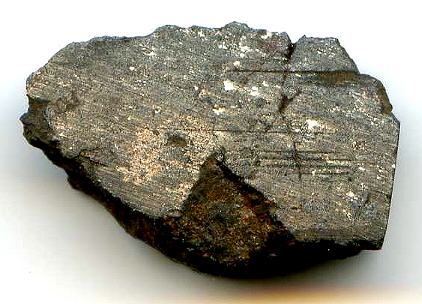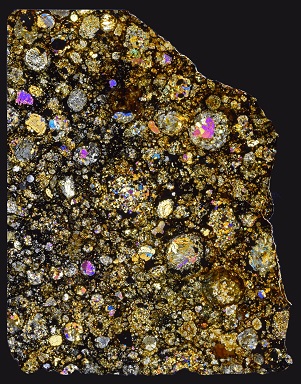C4-ungrouped
carbonaceous chondriteCarbonaceous chondrites represent the most primitive rock samples of our solar system. This rare (less than 5% of all meteorite falls) class of meteorites are a time capsule from the earliest days in the formation of our solar system. They are divided into the following compositional groups that, other than Click on Term to Read More grouplet

Found 1937
38° 2′ N., 101° 59′ W. A very weathered mass of 4.5 kg was found by Harvey Nininger in Hamilton County, Kansas. Coolidge was originally classified as a metamorphosed member of the reducedOxidation and reduction together are called redox (reduction and oxidation) and generally characterized by the transfer of electrons between chemical species, like molecules, atoms or ions, where one species undergoes oxidation, a loss of electrons, while another species undergoes reduction, a gain of electrons. This transfer of electrons between reactants Click on Term to Read More subtype of the CV3 group due to certain similarities: 1) an abundance of FeNi-metal and troiliteBrass colored non-magnetic mineral of iron sulfide, FeS, found in a variety of meteorites. Click on Term to Read More; 2) chondrulesRoughly spherical aggregate of coarse crystals formed from the rapid cooling and solidification of a melt at ~1400 ° C. Large numbers of chondrules are found in all chondrites except for the CI group of carbonaceous chondrites. Chondrules are typically 0.5-2 mm in diameter and are usually composed of olivine Click on Term to Read More and refractory objects that are depleted in Na and K; and 3) a matrixFine grained primary and silicate-rich material in chondrites that surrounds chondrules, refractory inclusions (like CAIs), breccia clasts and other constituents. Click on Term to Read More composed of olivineGroup of silicate minerals, (Mg,Fe)2SiO4, with the compositional endpoints of forsterite (Mg2SiO4) and fayalite (Fe2SiO4). Olivine is commonly found in all chondrites within both the matrix and chondrules, achondrites including most primitive achondrites and some evolved achondrites, in pallasites as large yellow-green crystals (brown when terrestrialized), in the silicate portion Click on Term to Read More (Noguchi, 1994). Nevertheless, significant differences exist between these chondritesChondrites are the most common meteorites accounting for ~84% of falls. Chondrites are comprised mostly of Fe- and Mg-bearing silicate minerals (found in both chondrules and fine grained matrix), reduced Fe/Ni metal (found in various states like large blebs, small grains and/or even chondrule rims), and various refractory inclusions (such Click on Term to Read More; in contrast to the reduced CV3 chondrites, Coolidge matrix is depleted in Na, chondruleRoughly spherical aggregate of coarse crystals formed from the rapid cooling and solidification of a melt at ~1400 ° C. Large numbers of chondrules are found in all chondrites except for the CI group of carbonaceous chondrites. Chondrules are typically 0.5-2 mm in diameter and are usually composed of olivine Click on Term to Read More compositions are different, and thermal metamorphism was greater (temperatures to ~900°C for a short duration).
Thermoluminescence (TL)Emission of light caused by the heating of certain minerals. sensitivity analysis was applied to Coolidge, and it was resolved as a
petrologic typeMeasure of the degree of aqueous alteration (Types 1 and 2) and thermal metamorphism (Types 3-6) experienced by a chondritic meteorite. Type 3 chondrites are further subdivided into 3.0 through 3.9 subtypes. 4. Kallemeyn and Rubin (1995) found features in Loongana 001 which suggested a genetic relationship exists (
i.e., same
parent bodyThe body from which a meteorite or meteoroid was derived prior to its ejection. Some parent bodies were destroyed early in the formation of our Solar System, while others like the asteroid 4-Vesta and Mars are still observable today. Click on Term to Read More) with Coolidge. For example, they both have comparable matrix abundances, comparable petrographic types, similar chondrule sizes, similar olivine Fa abundances, high refractory lithophile and refractory siderophile abundances, low abundances of all
volatileSubstances which have a tendency to enter the gas phase relatively easily (by evaporation, addition of heat, etc.). elementSubstance composed of atoms, each of which has the same atomic number (Z) and chemical properties. The chemical properties of an element are determined by the arrangement of the electrons in the various shells (specified by their quantum number) that surround the nucleus. In a neutral atom, the number of Click on Term to Read More groups, and similarities in their opaque assemblages.
Recent petrographic studies of Coolidge, Loongana 001, and HaH 073 (W3, S1), defined a petrologic type range of 3.8–4, implying that these meteorites are not simply metamorphosed samples of CV3 material. Recent studies of HaH 073 show an O-isotopic plot on the CCAM line close to Coolidge, and it has many of the features common to the Coolidge–Loongana grouplet. However, HaH 073 reveals some differences with Coolidge–Loongana;
e.g., more ferroan olivine, slightly higher matrix abundance, slightly smaller chondrule size, not all volatiles have low abundances, and slightly different O-isotopic values). Based on these differences and other abundance ratios, Huber
et al. (2006) were unable to establish a classification for HaH 073 within the Coolidge–Loongana grouplet. However, in-depth studies of HaH 073, Coolidge–Loongana, and Sah 00182 by Choe
et al. (2010) led them to conclude that, given heterogeneous volatile element abundances, these meteorites are likely related. Two other recently found meteorites, NWA 779 and Sah 00177 (
photo courtesy of L. Labenne), exhibit low-fayalite olivine compositions and refractory element abundances characteristic of this grouplet, and thus one or both could conceivably be recognized as additional samples constituting the membership of five which is necessary to establish a new carbonaceous
chondriteChondrites are the most common meteorites accounting for ~84% of falls. Chondrites are comprised mostly of Fe- and Mg-bearing silicate minerals (found in both chondrules and fine grained matrix), reduced Fe/Ni metal (found in various states like large blebs, small grains and/or even chondrule rims), and various refractory inclusions (such Click on Term to Read More group.
Only the karoondaites (CK) have petrologic type 4 members in common with the three (possibly four) Coolidge-type meteorites, but current
oxidationOxidation and reduction together are called redox (reduction and oxidation) and generally characterized by the transfer of electrons between chemical species, like molecules, atoms or ions, where one species undergoes oxidation, a loss of electrons, while another species undergoes reduction, a gain of electrons. This transfer of electrons between reactants Click on Term to Read More state and bulk composition studies solidly place these meteorites in their own distinct carbonaceous chondrite grouplet. For example, the matrix of CK4 chondrites consists of both olivine and sodic
plagioclaseAlso referred to as the plagioclase feldspar series. Plagioclase is a common rock-forming series of feldspar minerals containing a continuous solid solution of calcium and sodium: (Na1-x,Cax)(Alx+1,Si1-x)Si2O8 where x = 0 to 1. The Ca-rich end-member is called anorthite (pure anorthite has formula: CaAl2Si2O8) and the Na-rich end-member is albite Click on Term to Read More, while no plagioclase is present in Coolidge matrix. CK chondrites are not depleted in Na or K. In addition, Coolidge has a finer-grained matrix and exhibits compositional differences in
spinelMg-Al oxide, MgAl2O4, found in CAIs. minerals. In contrast to Coolidge, CK chondrites are more highly
oxidizedOxidation and reduction together are called redox (reduction and oxidation) and generally characterized by the transfer of electrons between chemical species, like molecules, atoms or ions, where one species undergoes oxidation, a loss of electrons, while another species undergoes reduction, a gain of electrons. This transfer of electrons between reactants Click on Term to Read More as attested by the presence of
magnetiteFe oxide, Fe2+Fe3+2O4, containing oxidized iron (Fe3+) found in the matrix of carbonaceous chondrites and as diagnostic component in CK chondrites. In CK chondrites, magnetite is typically chromian, containing several wt. % Cr2O3. Click on Term to Read More with high-Ni sulfides instead of FeNi-metal and troilite. The Coolidge grouplet is also separated by its highly fractionated moderately
volatile elementsChemical elements that condense (or volatilize) at relatively low temperatures. The opposite of volatile is refractory. Volatile elements can be divided into moderately volatile (Tc = 1230–640 K) and highly volatile (Tc < 640 K). The moderately volatile lithophile elements are: Mn, P, Na, B ,Rb, K, F, Zn. The moderately Click on Term to Read More, higher than all other
meteoriteWork in progress. A solid natural object reaching a planet’s surface from interplanetary space. Solid portion of a meteoroid that survives its fall to Earth, or some other body. Meteorites are classified as stony meteorites, iron meteorites, and stony-iron meteorites. These groups are further divided according to their mineralogy and Click on Term to Read More groups. The finding of Al-rich inclusions unique from other carbonaceous chondrites also supports this classification. Coolidge has a CRE age of 37.7 m.y. The Coolidge specimen shown above is a 1.1 g cut fragment, and the bottom image is an excellent petrographic
thin sectionThin slice or rock, usually 30 µm thick. Thin sections are used to study rocks with a petrographic microscope. micrograph of Coolidge, shown courtesy of Peter Marmet.
 click on image for a magnified view
click on image for a magnified view Photo courtesy of Peter Marmet








